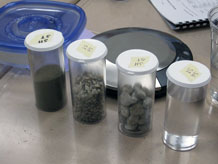Why are these ships in a field?
4. Weigh materials for the mini-lakes
Introduce Science Notebooks
Distribute Science Notebooks to the class and read the letter inside the front cover. Highlight the following points about notebook use:
- Scientists keep a written record of their questions, predictions, the data they collect (drawing, tables, graphs, notes, etc.), and their conclusions. You'll use your notebooks as scientists use theirs.
- Science classes begin with opening notebooks and recording the date. Notebooks are used throughout the class to record data, ideas, and questions as they arise.
- Use your notebooks to look back at predictions, procedures, data, conclusions, and ideas, so that procedures can be repeated. Your notebook will help you see how your ideas are growing and changing.
- Use your notebooks just for things related to science. Drawings or notes that are not related to your science work could make it more difficult to find information you need later on.
Identify pairs of students who will work together on a mini-lake. Distribute materials.
Introduce tare weight

Introduce tare weight with one of the empty plastic vials:
- No. There will be less than 150 grams of sand in the container, because the container and cover weigh something. To weigh 150 grams of sand, we'll need the scale to read 150 plus the weight of the container and cover.
Introduce the term "tare weight" (tare rhymes with air). This is the term used to describe the weight of an empty container, including its cover. It's important to know tare weight in order to determine the weight of just the material that's in a container. Ask groups to put an empty vial and its cover on the digital scale. Is there agreement about the weight of the vial and cover? Once students determine the tare weight, have them record it on the [Making mini-lakes] page in their Science Notebooks.
Weigh materials

The weight on the index card indicates the weight of sand, gravel, and water students will add to the vials. There is no specific weight of rocks students should use.
- Have students weigh the assigned amount of sand, gravel, and water, as well as the rocks, in the vials. They can use the plastic spoons to make small adjustments to the weight.
- Remind them to include the cover as they weigh the vials of materials.
- They should also weigh the sandwich box and cover, and record all weights in the Weight column of the table on the [Making mini-lakes] page of their Science Notebooks.
- Each pair should end up with four covered vials, which they will use in the next class. The vials of gravel, sand, and water should all have the same weights.
- Have pairs label their vials with their initials, using the masking tape.
Note: The only data students enter on this page during Investigation 1 are the vial tare weight (including cover) and the Weight data in the table. In Investigation 2 they will enter the Volume data, the weight of the completed mini-lake, and answer the reflection questions.
Tell students that in the next science class they will measure the volumes of the lake materials, add the materials to the sandwich boxes, and design their lakes.



